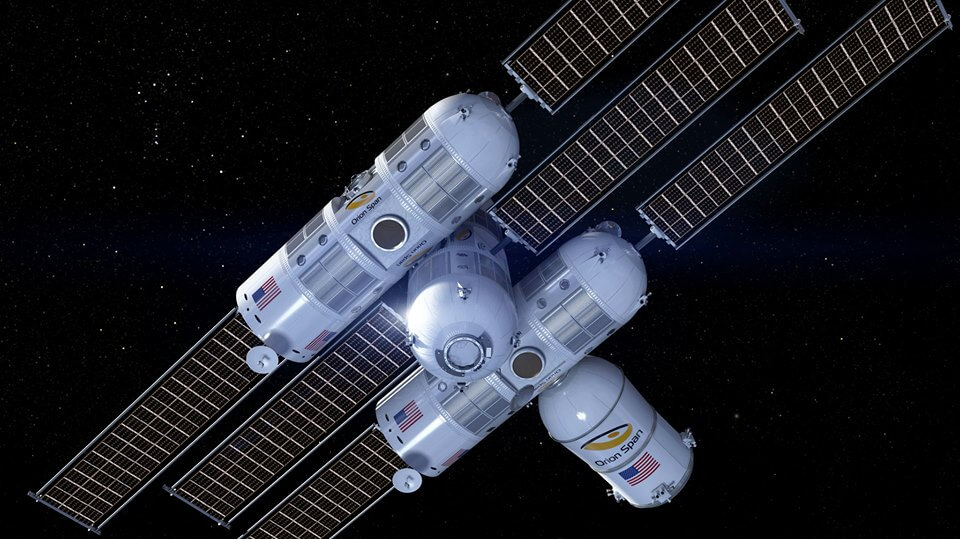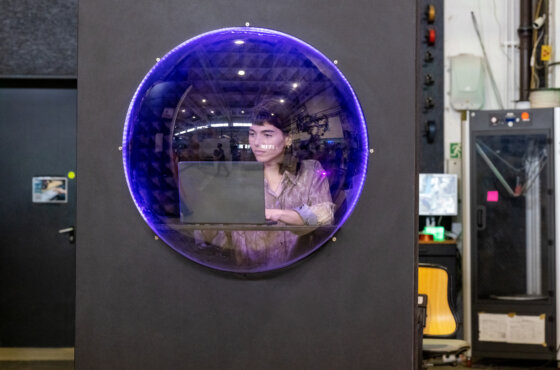California company creates space hotel in Earth orbit
Are you ready to take a vacation spinning around the earth? So far the most correct answer to this question is this: is it already possible? BBC Russian Service tells how to stay in a space hotel.

Photos: Facebook Orion Span, Inc.
Almost a year ago, in April 2018, at the Space 2.0 conference in San Jose (California), it was announced that Aurora Station would become the world's first hotel in orbit.
Aurora guests will live in a room the size of a large business jet and will be able to enjoy stunning views of the Earth and such colorful atmospheric phenomena as the Northern Lights for 12 days.
If you know something about how everything happens on the ISS, with real astronauts, do not worry, you will not have to drink water obtained from your own recycled urine.
Aurora Station is planned as a lightweight, luxury version of life on the International Space Station, so to speak, the ISS-Lite.
And yet it will happen in real space, in orbit, in 200 miles above our planet. Not to mention the fact that the cost will be very expensive.
From those who want no end
The time spent in space aboard the Aurora Station (launch into orbit is planned in 2022) will cost tourists a lot of money - the cheapest tickets cost 9,5 million dollars per person.
But, according to Orion Span, which is behind this business, there is no end to those who want to - everything has already been booked almost seven months in advance.
“Part of what we want to do is introduce people to the experiences of professional astronauts in space,” says Frank Bunger, founder and chief executive of Orion Span.
“However, we expect that most guests will not be able to tear themselves away from the windows... Well, if someone gets bored, we have prepared a virtual reality program. You can do whatever you want in it - swim in the vacuum of space, walk on the surface of the moon, play golf."
So, the life on a real orbital station will hardly touch the space tourists. Aurora Station, whose crowdfunding campaign was completed in early February, offers a lighter option to stay in orbit, not comparable with the ascetic conditions of the ISS.
However, some similarities will remain: four guests and two crew members will use the same special beds as professional astronauts, the food will also be frozen-dried, and everyone will have a series of serious health checks before they are allowed into orbit.
And of course, travelers will inevitably experience what any astronaut experiences when a rocket overcomes the Earth's gravitational force - overload.
In addition to contemplating the stars and the blue planet, Aurora visitors will engage in mini-experiments - for example, growing edible plants (which ISS crew members do on a regular basis).
However, drinking water for each of the guests will be delivered from Earth, they will not have to drink the product of processing their own urine (which is in the order of things on the ISS).
Beautiful gadget?
Many scientists view what is happening as an inevitable (big and important!) step that humanity is taking. However, as the old saying goes, don't say "gop" until...
After all, even to say that space travel for ordinary citizens is at the very beginning stage would be an exaggeration. "Aurora" created a boom in the media, but experts speak very carefully.
“You see, Aurora Station is still a beautiful toy, a gadget, so to speak,” says Christian Lesser from the research center for tourism and transport at the Swiss University of St. Gallen. “We’ll see if the project will be implemented.”
“Currently, space tourism is an area in which reality, fiction, fakes and science fiction are mixed. And they are mixed in such a way that it is difficult to distinguish one from the other, reality from good intentions,” adds Robert A. Gehlich from Embry-Riddle Aeronautical University (USA), the only educational institution in the world where the theory of space tourism is taught.
Commercial future
However, both Hehlich and Lesser agree that space tourism is already a reality.
It all started in 2001, when American Dennis Tito paid the Russian Space Agency for a seven-day stay on the ISS, as reported, 20 million dollars.
Some countries are already preparing for the future that this industry offers them: for example, 10 commercial spaceports are being built in the USA.
Eric Stallmer, president of the Federation for Commercial Spaceflight, and possibly the biggest advocate of the Aurora Station project, stresses that the United States already has a Commercial Space Launch Competitive Act, adopted in 2016, which regulates issues such as responsibility, risk, compensation, etc.
In fact, neither Gehlich nor Lesser are skeptics—both are more likely to take a “wait and see” approach to whether and how space tourism firms can deliver on their promises.
What remains to be determined are the safety and design requirements for a “civilian” spacecraft.
Banger argues that Aurora, given its use of the latest technology, simpler control systems and smaller size (which is important when determining the likelihood of a meteorite collision), is safer than the ISS.
However, even he admits that until the Aurora takes off, no one is safe from anything.
Danger of planning
And here several more questions arise - perhaps even more important: where to launch the Aurora and where, in what region of the planet, to then look for tourists returning from space.
And in general: this industry is still such that setting specific dates is a road leading to disappointment.
Virgin Galactic, for example, which in December carried out its first successful test launch and return of the device, is still nine years behind the previously scheduled schedule.
SpaceX and Blue Origin are only testing their ships for now, and XCUM Aerospace declared bankruptcy in 2017.
So there is a very real possibility that some of the now quite old candidates for the flight to the orbital hotel will simply be too old for space, or their health will have changed for the worse by the time the Aurora Hotel lights up their lights in low Earth orbit.
The assembly of the Aurora Station module has not yet begun.
Space hazards
And one more thing about health. In the case of the Aurora Station, those who suffer (at least to the smallest degree) with claustrophobia should think a hundred times before deciding to reserve a space in the space number. The number of lengths in 43.5ft and 14.1ft in diameter (and you can’t open a window there).
An important note for selfie lovers: with low gravity, your faces will not look very cool.
Yes, and you will most likely be sick, until your stomach adjusts to weightlessness.
Being in low gravity conditions for a long time weakens the bones and changes the structure of the eyeball so that it can affect the vision.
Tourists who have just flown in for 12 days are not likely to worry, but the hotel staff will certainly be affected.
Fortunately, microgravity does not adversely affect the menstrual cycle (although the lack of storage space for sanitation and limited water supplies may encourage women to use tablets).
It is known that NASA, for example, for a number of objective reasons (nature has not prepared a person for sexual intercourse in zero gravity), calls on astronauts to abstain from sex during flight, and the management of the Aurora project is unlikely to make an exception for tourists - so this element of a romantic trip to the orbit falls out.
What is more disturbing is the charged particles entering the cabin. Potentially, cosmic radiation, from which the ship is not completely isolated, can damage human DNA.
In the past, astronauts have reported that they have seen flashes of light - researchers believe that these could be cosmic rays that enter the optic nerves or the visual cortex of the brain.
When the border opens
“A space mission, in particular a commercial flight, cannot be carried out on the basis of the principle of ‘let’s try it and we’ll see,’” warns Gechlig.
“Spacecraft must be safe, their launches must not pose a threat to the environment, and, finally, this entire operation must be economically justified and profitable.”
As Lesser notes, space tourism is a part of natural progress, which cannot stop (and only slow down) even the hostile environment in which airless space research takes place.
“Just 30 years ago, Antarctica seemed inaccessible, impossible to study,” he emphasizes. “And now people go there all the time.” New frontiers are opening up before us all the time, and space is just the latest to be discovered.”
However, when this border opens, no one can say for sure.
Read also on ForumDaily:
The American company sells rooms in the space hotel "Aurora" in Earth orbit
Russia and the United States will send tourists into space on the route Gagarin
London startup has figured out how to make Internet accessible around the world.
Richard Branson approached sending tourists into space
Subscribe to ForumDaily on Google NewsDo you want more important and interesting news about life in the USA and immigration to America? — support us donate! Also subscribe to our page Facebook. Select the “Priority in display” option and read us first. Also, don't forget to subscribe to our РєР ° РЅР ° Р »РІ Telegram and Instagram- there is a lot of interesting things there. And join thousands of readers ForumDaily New York — there you will find a lot of interesting and positive information about life in the metropolis.











